Debug Non-Responsive Applications
Read in other languages: English Português 中文
There are many debugger tutorials that teach you how to set line breakpoints, log values, or evaluate expressions. While this knowledge alone gives you many tools to debug your application, real-world scenarios can be a little more complicated and require a more advanced approach.
In this article, we will learn how to locate the code that causes a UI crash without much prior knowledge of the project and fix the broken code on the fly.
The problem
If you want to follow the example, start by cloning this repository: https://github.com/flounder4130/debugger-example
Suppose you have a complex application that crashes when you perform some action. You know how to reproduce the error, but the difficulty is that you don't know which part of the code is responsible for this functionality.
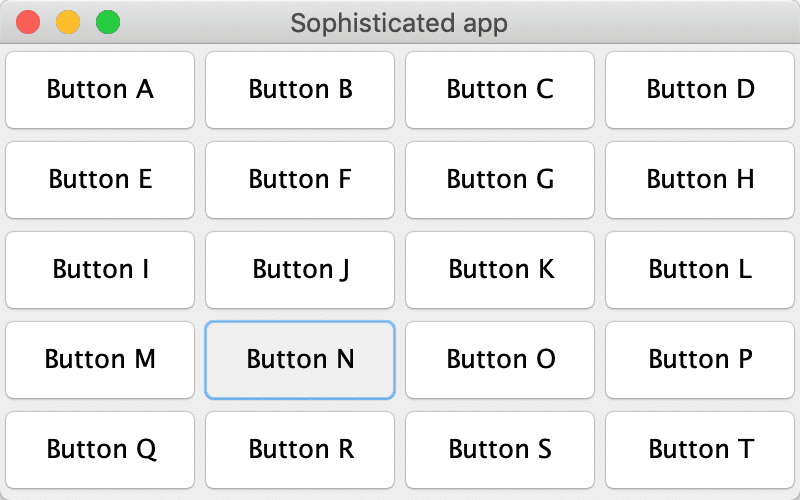
In our example application, the crash occurs when you click the Button N. However, it is not so easy to find the code that is responsible for this action:
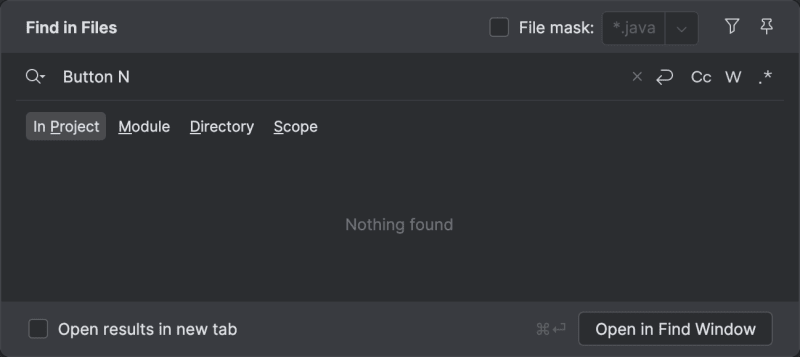
Let's see how we can use the debugger to find it.
Method breakpoints
The advantage of method breakpoints over line breakpoints is that they can be used in entire hierarchies of classes. How is this useful in our case?
If you look at the example project, you will see that all action classes are derived from the Action interface with a single method: perform().
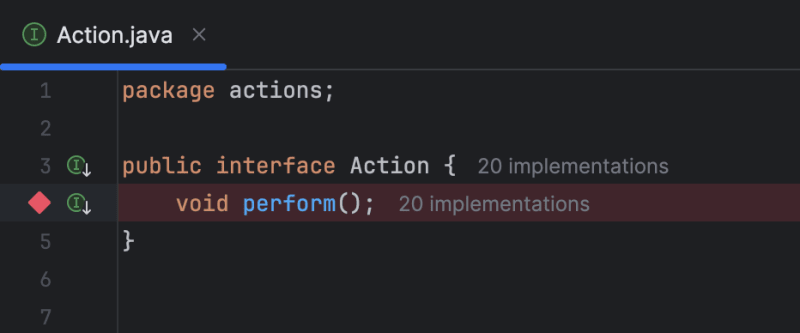
Setting a method breakpoint on this interface method will suspend the application every time one of the derived methods is called. To set a method breakpoint, click the line that declares the method.
Start the debugging session and click the Button N. The application is suspended on ActionImpl14. Now we know where the code corresponding to this button is located.

Although in this article we are focused on finding the bug, this technique can also save you a lot of time when you want to understand how something works in a large code base.
Pause application
The approach with method breakpoints works fine, but it relies on the assumption that we know something about the parent interface. What if this assumption is wrong, or we can't use this approach for some other reason?
Well, we can even do it without breakpoints. Click the Button N, and while the application hangs, go to IntelliJ IDEA. From the main menu, select Run | Debugging Actions | Pause Program.
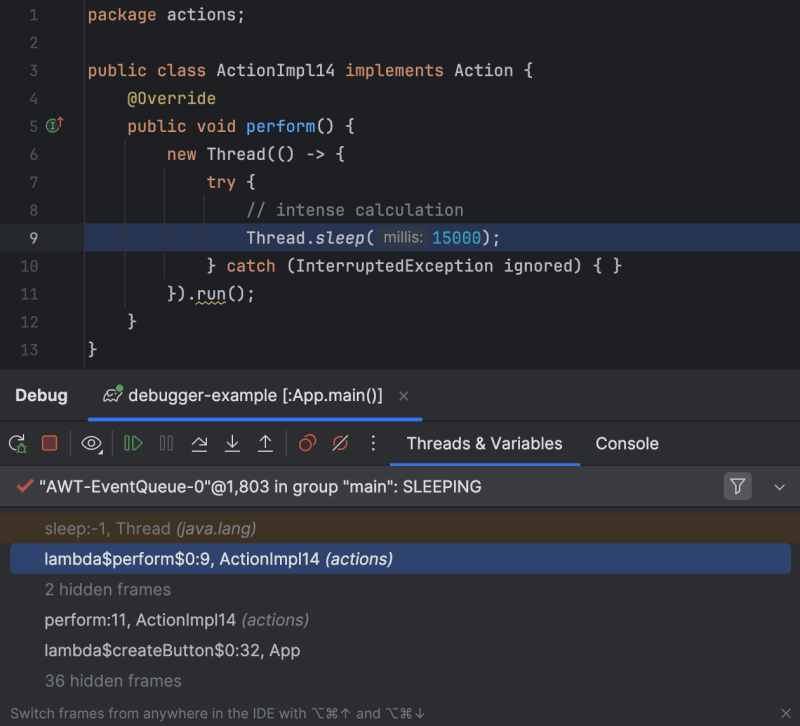
The application will suspend, allowing us to examine the current state of the threads in the Threads & Variables tab. This gives us an idea of what the application is doing at that moment. Since it is hanging, we can identify the method causing the block and trace it back to the call site.
This approach has some advantages over a more traditional thread dump, which we'll cover shortly. For example, it provides you with information about variables in a convenient form and allows you to control further execution of the program.
Tip: For more tips and tricks with Pause Program see Debugging without breakpoints and Debugger.godMode()
Thread Dumps
Finally, we can use a thread dump, which is not strictly a debugger feature. It is available regardless of whether you are using the debugger.
Click the Button N. While the application is crashing, go to IntelliJ IDEA. From the main menu, select Run | Debugging Actions | Get Thread Dump.
Explore the available threads on the left, and in AWT-EventQueue you will see what is causing the problem.

The disadvantage of thread dumps is that they only provide a snapshot of the state of the program at the time they were made. You cannot use thread dumps to explore variables or control program execution.
In our example, we don't need to resort to a thread dump. However, I still wanted to mention this technique as it can be useful in other cases, such as when you are trying to debug an application that has been launched without the debugging agent.
Understand the problem
Regardless of the debugging technique, we arrive at ActionImpl14. In this class, someone intended to do the work in a separate thread, but confused Thread.start() with Thread.run(), which runs code in the same thread as the calling code.
IntelliJ IDEA's static analyzer even warns us about this at design time:

A method that does heavy lifting (or sleeps a lot in this case) is called on the UI thread and blocks it until the method finishes. That's why we can't do anything in the UI for a while after clicking the Button N.
HotSwap
Now that we have discovered the cause of the error, let's correct the problem.
We could stop the program, recompile the code, and then run it again. However, it is not always wise to redeploy the entire application just because a small change was made.
Let's do it the smart way. First, fix the code using the suggested quick fix:
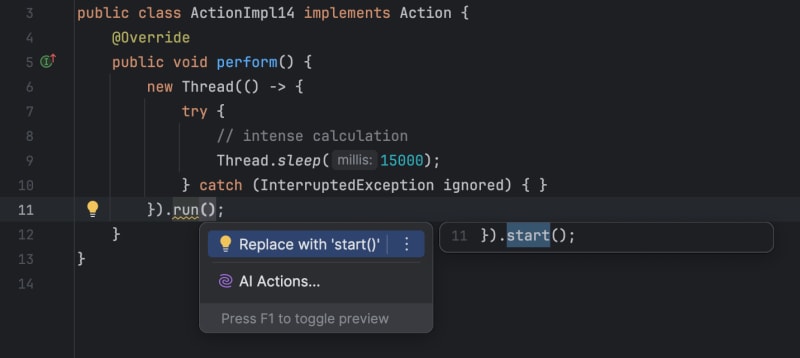
After the code is ready, click Run | Debugging Actions | Reload Changed Classes. A balloon appears, confirming that the new code has arrived in the VM.

Let's go back to the application and check. Clicking Button N no longer crashes the application.
Tip: Keep in mind that HotSwap has its limitations. If you are interested in extended HotSwap capabilities, it might be a good idea to take a look at advanced tools like DCEVM or JRebel
Summary
Using our reasoning and a couple of debugger features, we were able to locate the code that was causing a UI crash in our project. We then proceeded to fix the code without wasting time on recompilation and redistribution, which can be lengthy in real-world projects.
I hope you find the techniques described useful. Let me know what you think!
If you are interested in more articles related to debugging and profiling, check out some of my other articles:
- Debugger.godMode() – Hack a JVM Application with the Debugger
- Troubleshoot Slow Debugger
- What's Wrong with createDirectories()? - Guide to CPU Profiling
- Debug without Breakpoints
Stay tuned for more!
-
 How to Share a Lock Between Processes in Python Using MultiprocessingSharing a Lock Between Processes in PythonWhen attempting to use pool.map() to target a function with multiple parameters, including a Lock() object, ...Programming Published on 2024-11-05
How to Share a Lock Between Processes in Python Using MultiprocessingSharing a Lock Between Processes in PythonWhen attempting to use pool.map() to target a function with multiple parameters, including a Lock() object, ...Programming Published on 2024-11-05 -
 The difference between readonly and const in Type ScriptThese two features are similar in that they are both non-assignable. Can you explain exactly it? In this article, I will share the differences between...Programming Published on 2024-11-05
The difference between readonly and const in Type ScriptThese two features are similar in that they are both non-assignable. Can you explain exactly it? In this article, I will share the differences between...Programming Published on 2024-11-05 -
 How to Replicate C/C++ Loop Syntax in Python Using Range Function?for Loop in Python: Extending C/C Loop SyntaxIn programming, the for loop is a fundamental construct for iterating over sequences. While C/C emplo...Programming Published on 2024-11-05
How to Replicate C/C++ Loop Syntax in Python Using Range Function?for Loop in Python: Extending C/C Loop SyntaxIn programming, the for loop is a fundamental construct for iterating over sequences. While C/C emplo...Programming Published on 2024-11-05 -
 TechEazy Consulting Launches Comprehensive Java, Spring Boot & AWS Training Program with onth Free InternshipTechEazy Consulting is excited to announce the launch of our comprehensive training program designed for beginners, freshers, and professionals lookin...Programming Published on 2024-11-05
TechEazy Consulting Launches Comprehensive Java, Spring Boot & AWS Training Program with onth Free InternshipTechEazy Consulting is excited to announce the launch of our comprehensive training program designed for beginners, freshers, and professionals lookin...Programming Published on 2024-11-05 -
 Polyfills - a filler or a gaping hole? (Part-1)A few days back, we received a priority message in our organization's Teams chat, which read: Security Vulnerability found - Polyfill JavaScript d...Programming Published on 2024-11-05
Polyfills - a filler or a gaping hole? (Part-1)A few days back, we received a priority message in our organization's Teams chat, which read: Security Vulnerability found - Polyfill JavaScript d...Programming Published on 2024-11-05 -
 Shift operators and bitwise shorthand assignments1. Bit Shift Operators : Shift to the right. >>>: Unsigned right shift (zero-padded). 2. General Syntax of Shift Operators value > num-bits: Moves the...Programming Published on 2024-11-05
Shift operators and bitwise shorthand assignments1. Bit Shift Operators : Shift to the right. >>>: Unsigned right shift (zero-padded). 2. General Syntax of Shift Operators value > num-bits: Moves the...Programming Published on 2024-11-05 -
 How to Establish a Connection to a MySQL Database from Excel using VBA?How can VBA connect to MySQL database in Excel?Connecting to a MySQL Database using VBAAttempting to connect to a MySQL database in Excel using VBA ca...Programming Published on 2024-11-05
How to Establish a Connection to a MySQL Database from Excel using VBA?How can VBA connect to MySQL database in Excel?Connecting to a MySQL Database using VBAAttempting to connect to a MySQL database in Excel using VBA ca...Programming Published on 2024-11-05 -
 Test Automation: Guide to Selenium with Java and TestNGTest Automation has become an integral part of the software development process, allowing teams to increase efficiency, reduce manual errors, and deli...Programming Published on 2024-11-05
Test Automation: Guide to Selenium with Java and TestNGTest Automation has become an integral part of the software development process, allowing teams to increase efficiency, reduce manual errors, and deli...Programming Published on 2024-11-05 -
 My take on a Landing Page for DuckDuckGo“Why don’t you Google it?” is a common answer I get during conversations. The ubiquity of Google has even led to the new verb 'to Google". Bu...Programming Published on 2024-11-05
My take on a Landing Page for DuckDuckGo“Why don’t you Google it?” is a common answer I get during conversations. The ubiquity of Google has even led to the new verb 'to Google". Bu...Programming Published on 2024-11-05 -
 Why Does Turbo C++\'s \"cin\" Only Read the First Word?Turbo C 's "cin" Limitation: Reading Only the First WordIn Turbo C , the "cin" input operator has a limitation when dealing ...Programming Published on 2024-11-05
Why Does Turbo C++\'s \"cin\" Only Read the First Word?Turbo C 's "cin" Limitation: Reading Only the First WordIn Turbo C , the "cin" input operator has a limitation when dealing ...Programming Published on 2024-11-05 -
 Creating Docker Image of Spring Boot Application using BuildpacksIntroduction You have created a Spring Boot application. It is working great on your local machine and now, you need to deploy the applicatio...Programming Published on 2024-11-05
Creating Docker Image of Spring Boot Application using BuildpacksIntroduction You have created a Spring Boot application. It is working great on your local machine and now, you need to deploy the applicatio...Programming Published on 2024-11-05 -
 How to Protect PHP Code from Unauthorized Access?Protecting PHP Code from Unauthorized AccessProtecting the intellectual property behind your PHP software is crucial to prevent its misuse or theft. T...Programming Published on 2024-11-05
How to Protect PHP Code from Unauthorized Access?Protecting PHP Code from Unauthorized AccessProtecting the intellectual property behind your PHP software is crucial to prevent its misuse or theft. T...Programming Published on 2024-11-05 -
 React: Understanding React&#s Event SystemOverview of React's Event System What is a Synthetic Event? Synthetic events are an event-handling mechanism designed by React to ach...Programming Published on 2024-11-05
React: Understanding React&#s Event SystemOverview of React's Event System What is a Synthetic Event? Synthetic events are an event-handling mechanism designed by React to ach...Programming Published on 2024-11-05 -
 Why am I getting a 301 Moved Permanently Error when using Multipart/Form-Data POST requests?Multipart/Form-Data POSTsWhen attempting to POST data using multipart/form-data, error messages like the one provided can be encountered. Understandin...Programming Published on 2024-11-05
Why am I getting a 301 Moved Permanently Error when using Multipart/Form-Data POST requests?Multipart/Form-Data POSTsWhen attempting to POST data using multipart/form-data, error messages like the one provided can be encountered. Understandin...Programming Published on 2024-11-05 -
 How to Determine Temporal Boundaries in PHP Using Date and Time Objects?Determining Temporal Boundaries in PHPIn this programming scenario, we're tasked with ascertaining whether a given time falls within a predefined ...Programming Published on 2024-11-05
How to Determine Temporal Boundaries in PHP Using Date and Time Objects?Determining Temporal Boundaries in PHPIn this programming scenario, we're tasked with ascertaining whether a given time falls within a predefined ...Programming Published on 2024-11-05
Study Chinese
- 1 How do you say "walk" in Chinese? 走路 Chinese pronunciation, 走路 Chinese learning
- 2 How do you say "take a plane" in Chinese? 坐飞机 Chinese pronunciation, 坐飞机 Chinese learning
- 3 How do you say "take a train" in Chinese? 坐火车 Chinese pronunciation, 坐火车 Chinese learning
- 4 How do you say "take a bus" in Chinese? 坐车 Chinese pronunciation, 坐车 Chinese learning
- 5 How to say drive in Chinese? 开车 Chinese pronunciation, 开车 Chinese learning
- 6 How do you say swimming in Chinese? 游泳 Chinese pronunciation, 游泳 Chinese learning
- 7 How do you say ride a bicycle in Chinese? 骑自行车 Chinese pronunciation, 骑自行车 Chinese learning
- 8 How do you say hello in Chinese? 你好Chinese pronunciation, 你好Chinese learning
- 9 How do you say thank you in Chinese? 谢谢Chinese pronunciation, 谢谢Chinese learning
- 10 How to say goodbye in Chinese? 再见Chinese pronunciation, 再见Chinese learning

























